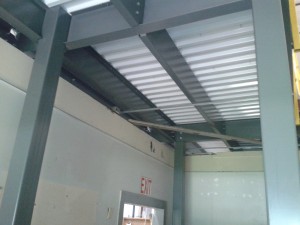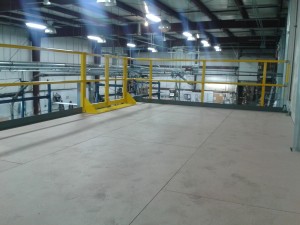I thought it might be a good idea to begin a little series in which we discuss some of the different mezzanine deck types available. To start things off, let’s talk about our most commonly used mezzanine deck type: the corrugated roof deck topped with resindek.
As the name implies, roof decks with resindek is a two-layered mezzanine deck surface. The structural component of the mezzanine deck is provided by a 1-1/2” corrugated steel roof deck. The gauge of the roof deck used varies depending on the loads the mezzanine deck is designed to support. The underside of the roof deck is painted white to help reflect light under the mezzanine deck. The corrugation of the roof deck doesn’t offer a very useable deck surface, so it needs to be skinned with a second material — in this case, resindek.
Resindek is a wood composite material specifically designed to provide a durable and affordable mezzanine deck surface. There are different grades of resindek depending on the loads the mezzanine deck is designed to support. Most commonly we will use an unfinished ¾” Resindek LD material which is designed to accommodate a combined pallet and pallet jack load of up to 2000 lbs. If we’re designing the mezzanine to support heavier loads, varieties are available for all the way up to an 8000 lb max load. It provides a smooth surface to roll your pallets across, both on and between panels, and doesn’t peel layers like plywood can.
Corrugated roof deck with resindek is easily our most popular mezzanine deck surface, largely due to its significant price advantage over other deck types. There are, however, some situations where it would not be the best option. As a wood based material, resindek can swell when it gets wet. During installation you leave a gap between panels about the width of a nickel to accommodate some swelling, but if the deck will be in a wet environment it is not the recommended tool for the job. In our next segment, we’ll talk about another deck type that would work better for wet environments.


